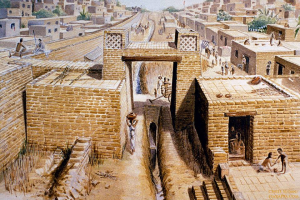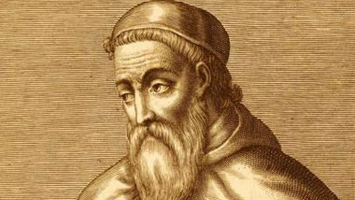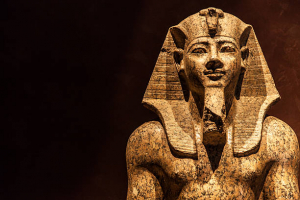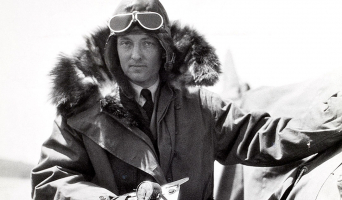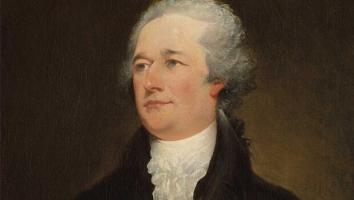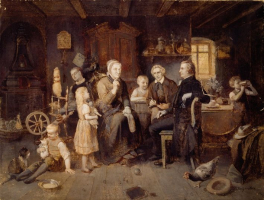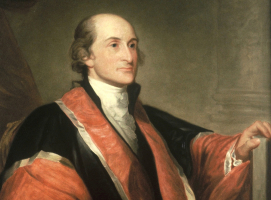Top 12 Facts About Valley Forge
Valley Forge was the third of the eighth winter encampment for the Continental Army's main body, commanded by General George Washington, at the time of the ... read more...American Revolutionary War. Valley Forge is famously remembered and depicted in famous works of art. In this list, we'll show you some of the facts you might not know about this historical area.
-
Alexander Hamilton (January 11, 1755, or 1757 – July 12, 1804) was an American revolutionary, statesman, and Founding Father of the United States. He was an influential interpreter and promoter of the U.S. Constitution, and was the founder of the Federalist Party, the nation's financial system, the United States Coast Guard, and the New York Post newspaper. Henry Lee III (January 29, 1756 – March 25, 1818) was an early American Patriot and U.S. politician who served as the ninth Governor of Virginia and as the Virginia Representative to the United States Congress. Lee's service during the American Revolution as a cavalry officer in the Continental Army earned him the nickname by which he is best known, "Light-Horse Harry". Both Alexander Hamilton and Henry Lee III contributed greatly to the American Revolutionary War.
After the engagement at Brandywine on September 11, 1777, Hessian General Wilhelm von Knyphausen led a British contingent on a strike toward Valley Forge. The goal was to capture the supplies stored there. Alexander Hamilton and “Light Horse Harry” Lee led the American forces that tried to intervene and were tasked with destroying the supplies there before they fell into British hands. The British burned a few buildings, obtained the supplies, and withstood the interference of Hamilton and Lee. This small action was dubbed “The Battle of Valley Forge.” This was one of many importance events that took place in Valley Forge before the winter encampment.
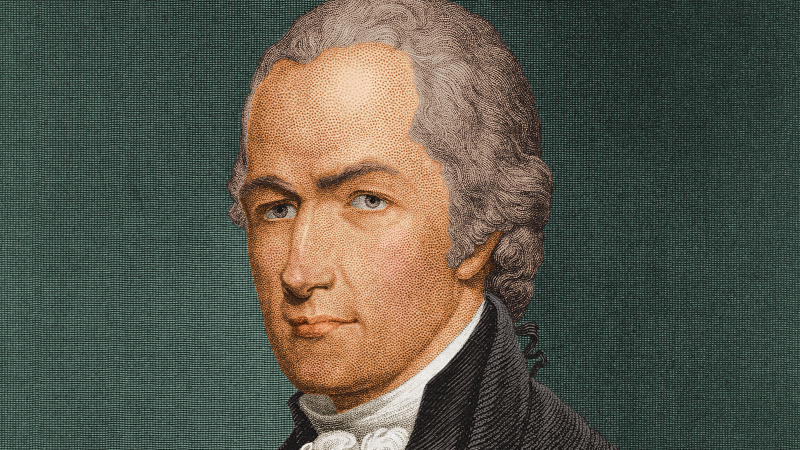
Alexander Hamilton - history.howstuffworks.com 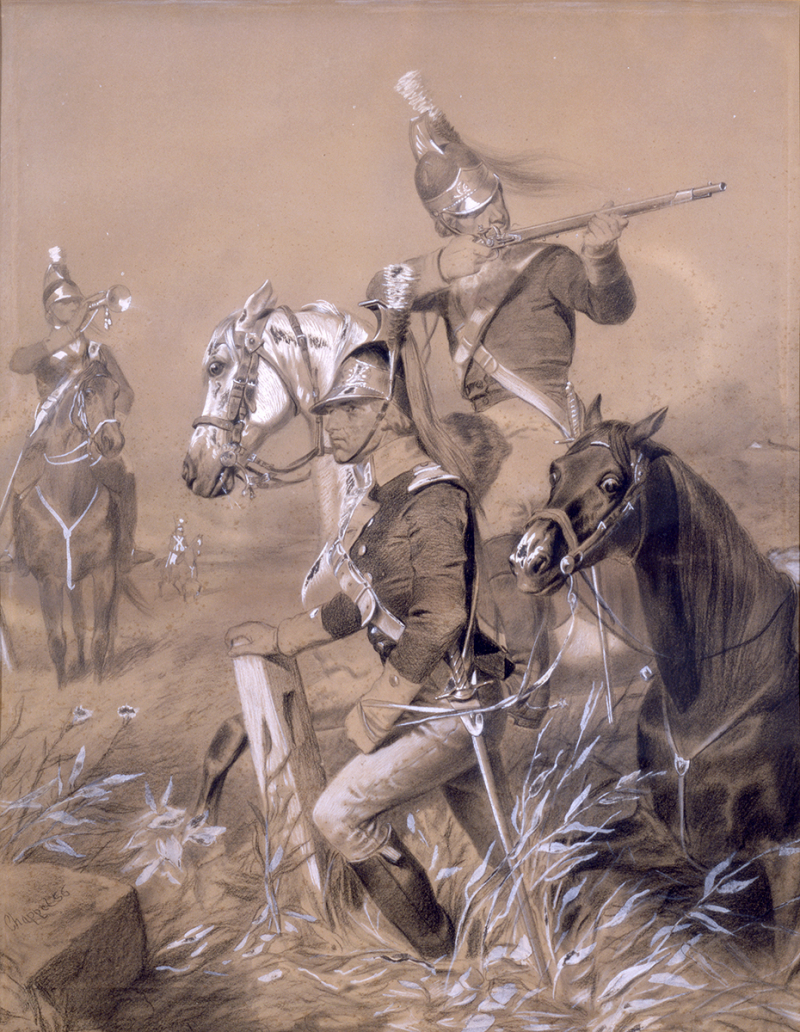
Alexander Hamilton on the battlefield - vahistorical.wordpress.com -
George Washington (February 22, 1732 – December 14, 1799) is one of the most important people in the history of the United States. He was an American military officer, statesman, and Founding Father who served as the first president of the United States from 1789 to 1797. Appointed by the Continental Congress as commander of the Continental Army, Washington led the Patriot forces to victory in the American Revolutionary War and served as the president of the Constitutional Convention of 1787, which created the Constitution of the United States and the American federal government.
While fighting the war against the British in Valley Forge, Washington also had to fight the war against his own Continental Congress. With the loss of Philadelphia, the capital of the rebelling colonies, and the success of the northern Continental forces under General Horatio Gates, a few delegates in the Continental Congress started to think a change in overall leadership was needed. Congress instituted a Board of War, with a few of Washington’s detractors as members. Through back channels, including his aide, John Laurens, who happened to be the son of the president of Congress, Henry intermediaries, and political maneuvering, Washington solidified his hold on the army and silenced most of his critics. The “Conway Cabal” was a part of this larger picture.
Only Washington's vastly underrated political instincts allowed him to deftly outmaneuver the near-treasonous Gates cabal and assert himself as the best chance America had to win its independence.
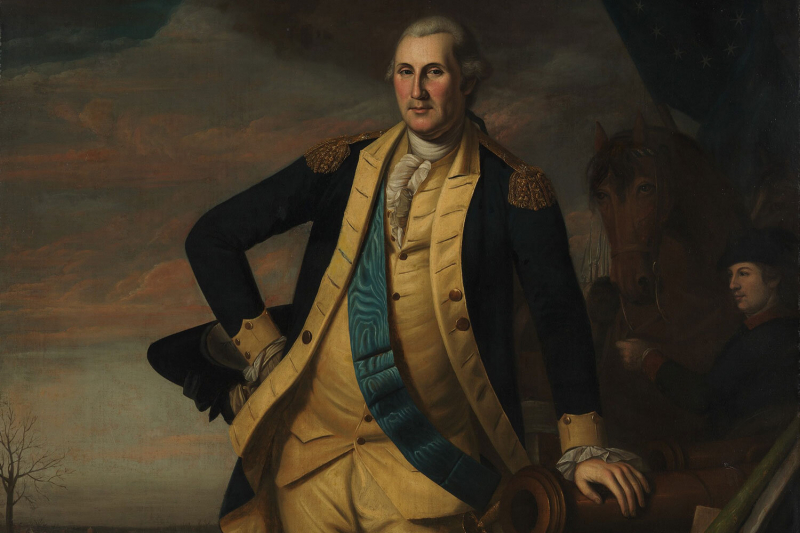
George Washington - www.americanacorner.com 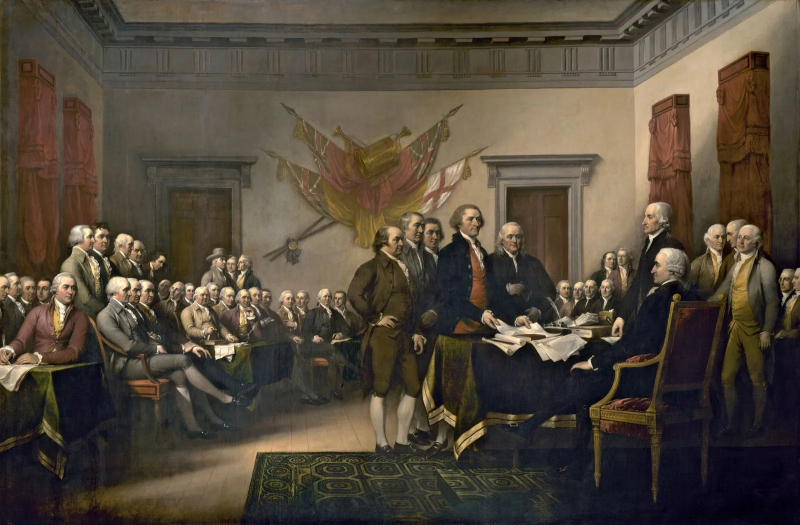
Washington's Continental Congress - www.britannica.com -
The mythical image of the musket-wielding Minuteman employing Indian-fighting techniques to devastate the squared ranks of Redcoats that most of us see today is unfortunately just a fictitious fancy. Prior to Valley Forge, the American soldiers had a tendency to cut and run at the first glint of a British bayonet charge. It was only after the Prussian soldier of fortune Baron Friedrich von Steuben arrived at Valley Forge to completely overhaul the Continental Army through a series of intense, non-stop drilling and training exercises that the American Army became a match for the military might of the British Empire.
Baron von Steuben (September 17, 1730 – November 28, 1794; full name: Friedrich Wilhelm August Heinrich Ferdinand von Steuben), was a Prussian military officer who played a leading role in the American Revolutionary War by reforming the Continental Army into a disciplined and professional fighting force. His contributions marked a significant improvement in the performance of US troops, and he is subsequently regarded as one of the fathers of the United States Army. Thanks to his dedication at Valley Forge, the American Army was physically and mentally prepared to take part in the fights against the British Empire and gain many victories for the American side, which contributed greatly to the victory of the American Revolutionary War.
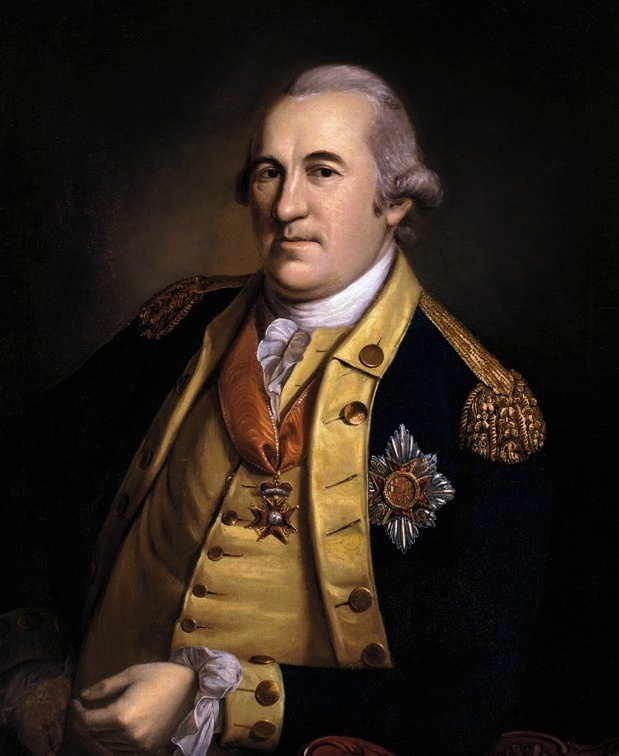
Baron von Steuben - Wikipedia 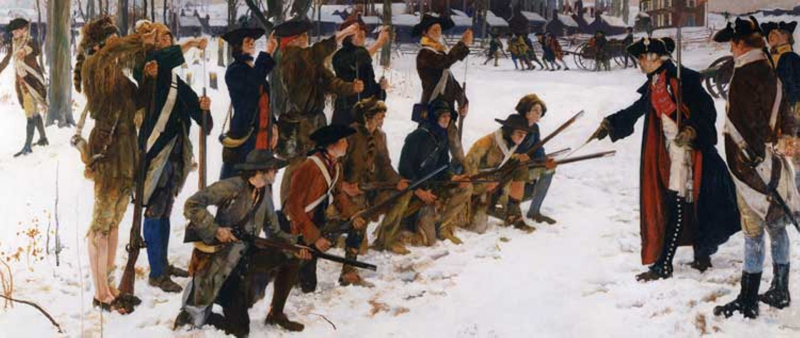
Steuben training the American Army - explorethearchive.com/valley-forge -
They do not appear in the famous paintings, nor in many of the accounts, but of the roughly 12,000 Continental Soldiers at Valley Forge, there are 750 black soldiers, freemen, and escaped slaves, a part of the 5000 or so African-Americans who enlisted to help America win its freedom. In fact, blacks made up some 20 percent of America’s colonial population in 1776; close to one-half million men, women, and children, 99 percent of them enslaved. While Washington was of course aware of the loyalty and grit displayed by black volunteers who had fought for the colonial cause in and around Boston – by now most patriots were familiar with the heroics of Crispus Attucks, the fugitive slave who fell during the Boston Massacre and is considered the first casualty of the Revolution – the idea of arming black men weighed heavily on the erstwhile Virginia planter whose subconscious was so invested in the lore of slave uprisings.
However, fearing a wave of runaway slaves donning British uniforms in exchange for their freedom, Washington somewhat reluctantly implored the Continental Congress to allow “freemen” to be granted the right to fight for the cause. The delegates acquiesced, and over the course of the revolution, some 5,000 black men enlisted in the Continental Army. In a footnote buried in the mists of time, the first casualty recorded at the Valley Forge winter encampment was a freeman from Connecticut’s 7th Regiment known to posterity only by his given name of Jethro.
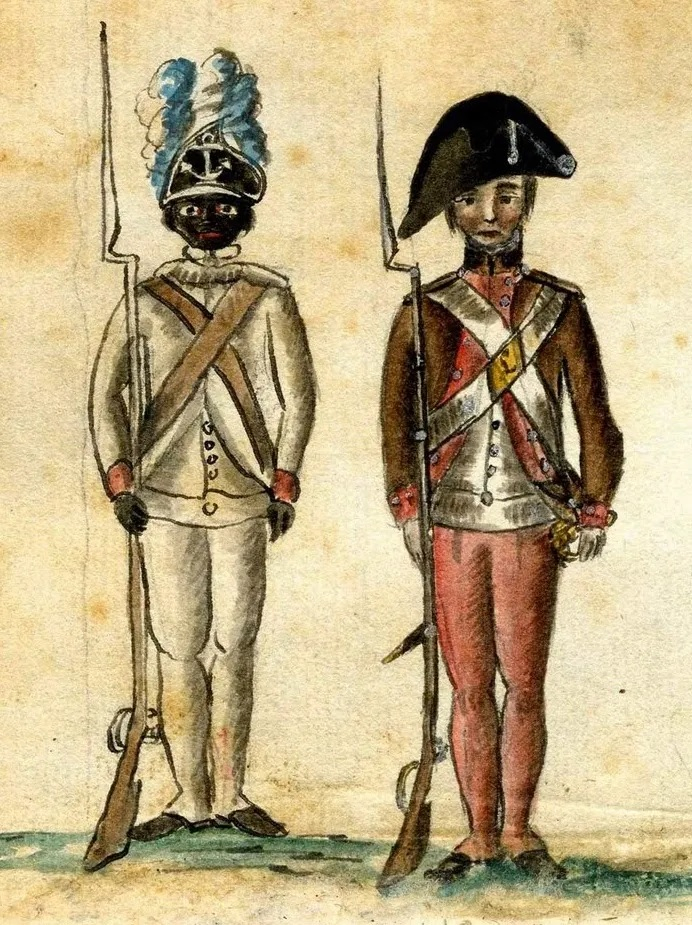
Black and White soldiers fought together - militaryhistorynow.com 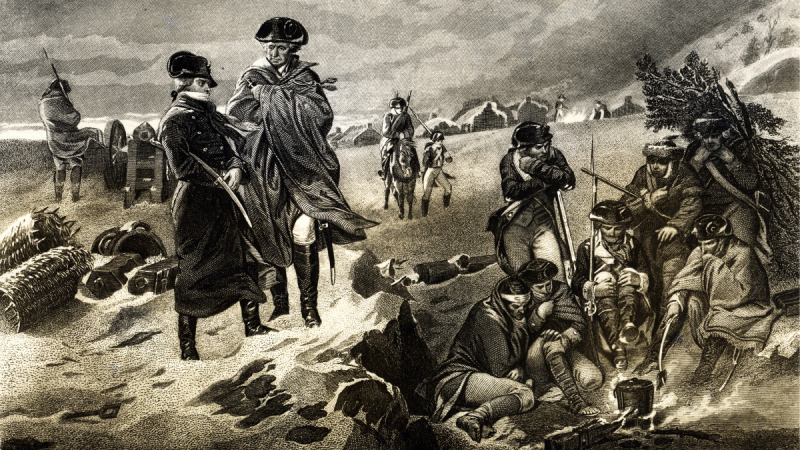
Photo: www.history.com -
This perhaps was the most interesting fact about the encampment in Valley Forge. With 12,000 soldiers, hundreds of camp followers, and more than 2,000 hastily erected huts and cabins, the camp at Valley Forge would overnight become the seventh-largest metropolis in the nascent United States. Besides the 12,000 soldiers serving in the ranks and other military capacities, the winter cantonment at Valley Forge had a sizable population of women. The long winter will contain an uncountable amount of work that needs the hand of a woman. Therefore, there were more than 400 women served in the camp. The females undertook a myriad of roles, from laundry and cooking to sewing and nursing, and many other unnamed works. Officer wives, including Martha Washington, were also present during the six-month encampment.
It was also for a time the de facto capital of the country. With a rump faction of Congress virtually unable to function while in exile in York, Pennsylvania, Washington, and his staff would temporarily assume the awesome responsibility of keeping the wheels of governance turning until the elected civilians could resume their leadership roles. The general and his staff corresponded with state governors and legislators, senior military officers stationed throughout the former colonies, congressional delegates, and even Ben Franklin and other American diplomats abroad.
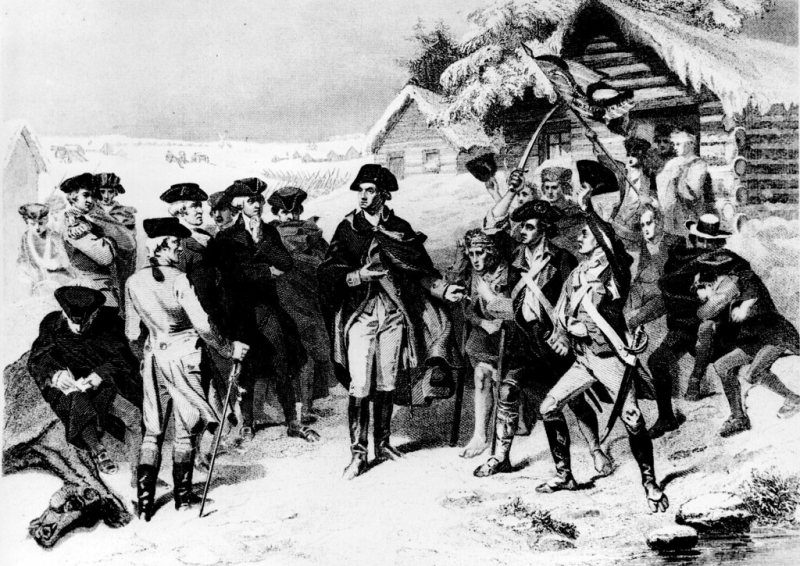
Photo: militaryhistorynow.com 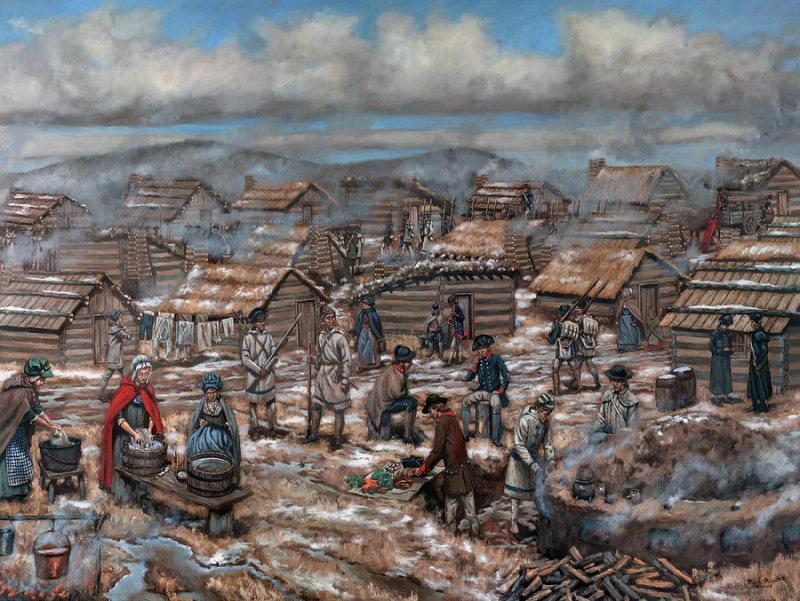
Photo: fineartamerica.com -
Before even reaching the winter encampment, Washington was already vociferously complaining to his brigadiers about the number of “summer soldiers” simply vanishing from his army’s ranks. Once the encampment was established, those desertions multiplied daily, reaching such epic proportion that the commander-in-chief was forced to issue a series of General Orders threatening his junior officers with dismissal if they failed to convene multiple daily roll calls – the only way, he felt, to ensure that men abandoning their posts could not get too far before specially-designated mounted units could round them up and return them. Yet despite the most recidivist offenders being hanged in the camp’s parade grounds, still they left Valley Forge.
It was not unusual for regimental commanders to find scores of grumbling soldiers outside their huts threatening to desert en masse “for want of victuals.” Loyalist spies stationed along the Hudson Highlands spotted so many New Englanders simply walking home that they (mistakenly) warned the British in New York that the Continentals might be massing for a rearguard surprise attack on the city. “The spirit of desertion never before rose to such a threatening height as at the present time,” an alarmed Washington wrote to the Continental Congress. Come the spring of 1778, the combination of death and “self-granted furloughs” had reduced the commander in chief’s force to barely 8,000 able-bodied men.
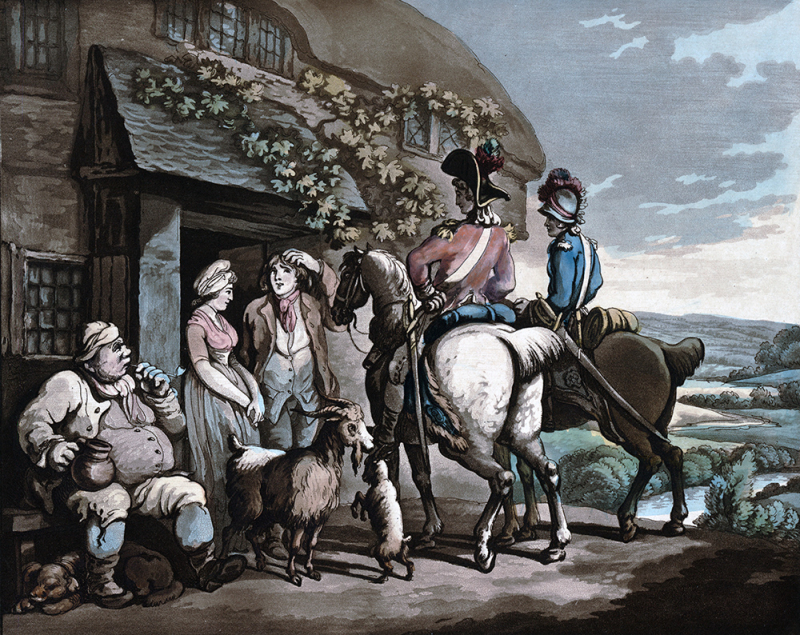
Photo: allthingsliberty.com 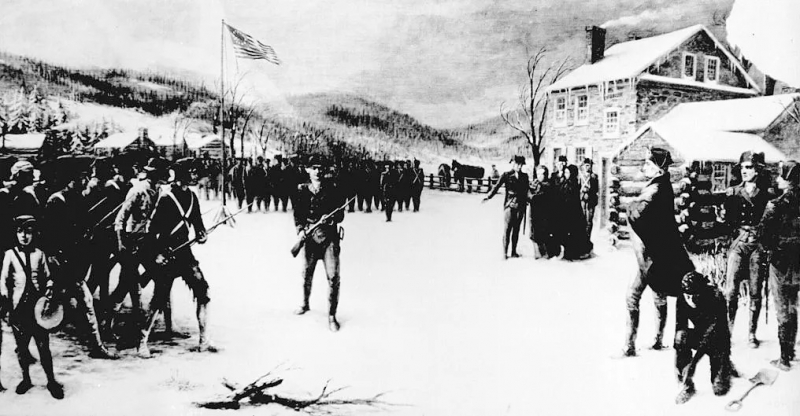
Photo: militaryhistorynow.com -
Foreign soldiers were equally as important to the survival and ultimate victory of the Continental Army as America’s homegrown officers at Valley Forge. Another of the more enduring myths of the American Revolution is that of the musket-wielding Minuteman blending into a copse of woods and firing into the squared ranks of attacking redcoats. In fact, it was the Continentals’ utter disregard for the linear tactics of what military experts of the era called “fire discipline” that nearly doomed their fight for independence. This discipline, gradually infused into the Continental Army at Valley Forge almost solely by the Prussian volunteer Count Friedrich von Steuben, demanded that infantry battalions on the march be able to change formations while maintaining cohesion and wheel in unison to form battle lines – a concept quite foreign to American units, who tended to march in Indian-file.
Von Steuben was not alone in his contributions at Valley Forge. Much as Washington depended on Lafayette’s sound advice, he relied upon Lafayette’s fellow Frenchman the military engineer General Louis du Portail to erect the defensive parapets that girded Valley Forge and the Polish Count Casimir Pulaski to transform his motley collection of mounted mail riders and scouts into a coherent American cavalry. Pulaski, like scores of other foreigners including the hulking Bavarian volunteer General Johann de Kalb, would ultimately sacrifice their life for the cause of America’s independence.
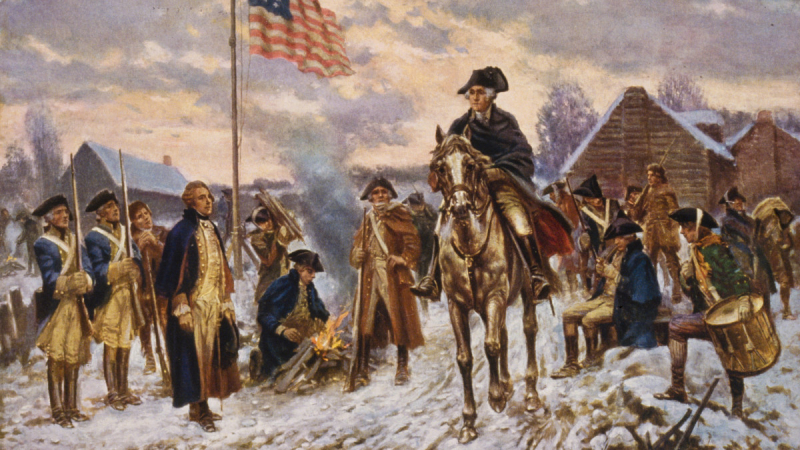
Friedrich von Steuben at Valley Forge - militaryhistorynow.com Video: This Day In History -
The encampment in Valley Forge had more inhabitants than most American cities, including all kinds of from black to white, from soldiers, and camp followers to freed men and women. With more than 2,000 hastily erected huts and cabins, the camp at Valley Forge became the seventh-largest metropolis in the nascent United States. However, great numbers of people also died here in the camp for many reasons.
Due to shortages of food, and a lack of proper hygiene, sanitation, and medical knowledge at the time, over 2,000 soldiers perished during the winter. Considering the situation in America at the moment the encampment occurred, it is easy to point out that the shortages of food will be a big problem, especially when it had more inhabitants than most American cities at the time. Other than that, people at the camp have to deal with many of the diseases that were considered almost uncurable at the time, including diseases from scurvy to smallpox, dysentery, and other maladies. The fighting itself sure took a lot of soldiers' life away, but those diseases also contributed to the loss of men in the camp. As the result, one out of every six soldiers that marched into Valley Forge in December did not march back out in June.
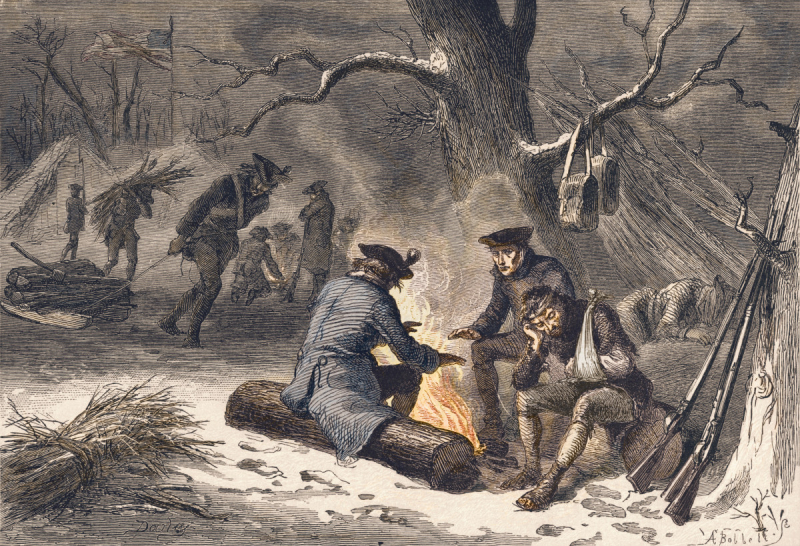
Photo: www.history.com Video: Daily Dose Documentary -
While at Valley Forge, Washington was in danger of being deposed and replaced as commander in Chief of the Continental Army. This was the reason for all the intrigue and treachery that happened at the time. This also put Washington in a position where he had to fight two wars at once: one against the British in Valley Forge, and one against his own Continental Congress.
Following the Horatio Gate’s astounding defeat of a large British expeditionary force at the Battle of Saratoga in early October 1777, there was a concerted and vicious back-channel effort among a bevy of statesmen led by the Massachusetts congressmen John Adams to demote Washington and install Gates at the head of the army. Gates and his supporters within both Congress and the military were not averse to what the Washington loyalist Alexander Hamilton labeled the “execrable coup d’état.”
To that end, while Washington worked tirelessly to keep his army from either dissolving or perishing at Valley Forge, Gates assiduously worked behind the scenes to undermine him in the field. Only Washington’s superior political instincts, heretofore vastly underrated, allowed him to maintain his position as he deftly outmaneuvered the Gates cabal with a series of actions that rallied an influential faction of statesmen and military officers to his side.
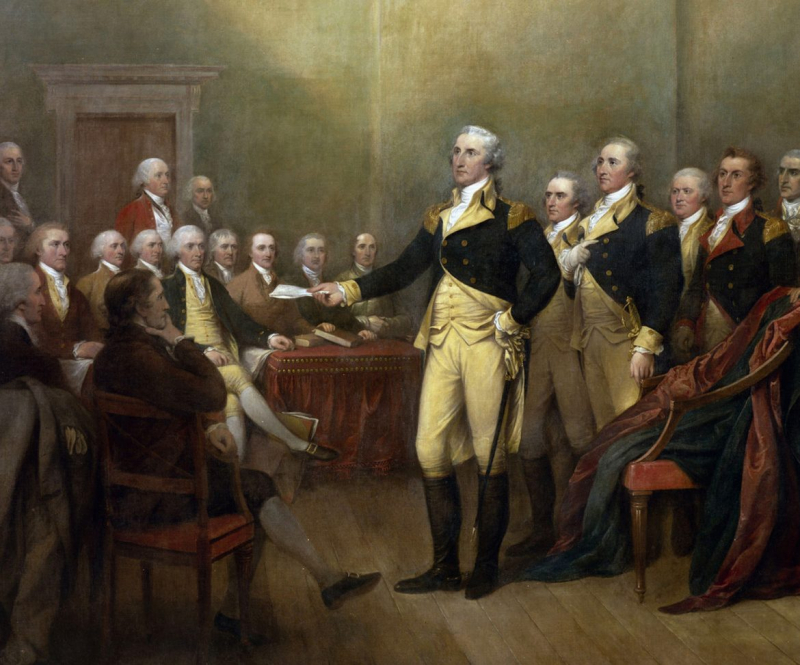
Photo: allthingsliberty.com 
Argument in the Continental Congress - www.thimblesandacorns.com -
This happened on Sunday, February 22, 1778. The bountiful fields of Chester, Montgomery, and Bucks counties had produced great crop yields, but local farmers, millers, and merchants much preferred to smuggle their goods into British-occupied Philadelphia in exchange for pound sterling and sometimes even gold as opposed to the nearly worthless Continental scrip. This leads to the shortage of food in the camp at Valley Forge. A week before the date, the camp’s larders had run out of food, and seven days with no rations had not only again raised the prospect of famine but had lent the winter cantonment the trappings of a refugee camp.
Nonetheless, that evening as Washington, his wife Martha, and his closest aids choked down a meager supper of spoiled meat and hickory nuts, a fife and drum corps from Pennsylvania’s Philadelphia regiment appeared outside the small farmhouse that Washington used as his headquarters to serenade him with an impromptu birthday concert. During the whole preparation for the birthday celebration, Washington retired to bed. Martha Washington even managed to scrape up 15 shillings with which to thank the bandleader. However, when he awoke and experience the celebration, Washington feared that the tribute was too reminiscent of the British custom of military bands honoring the king on his birthday.
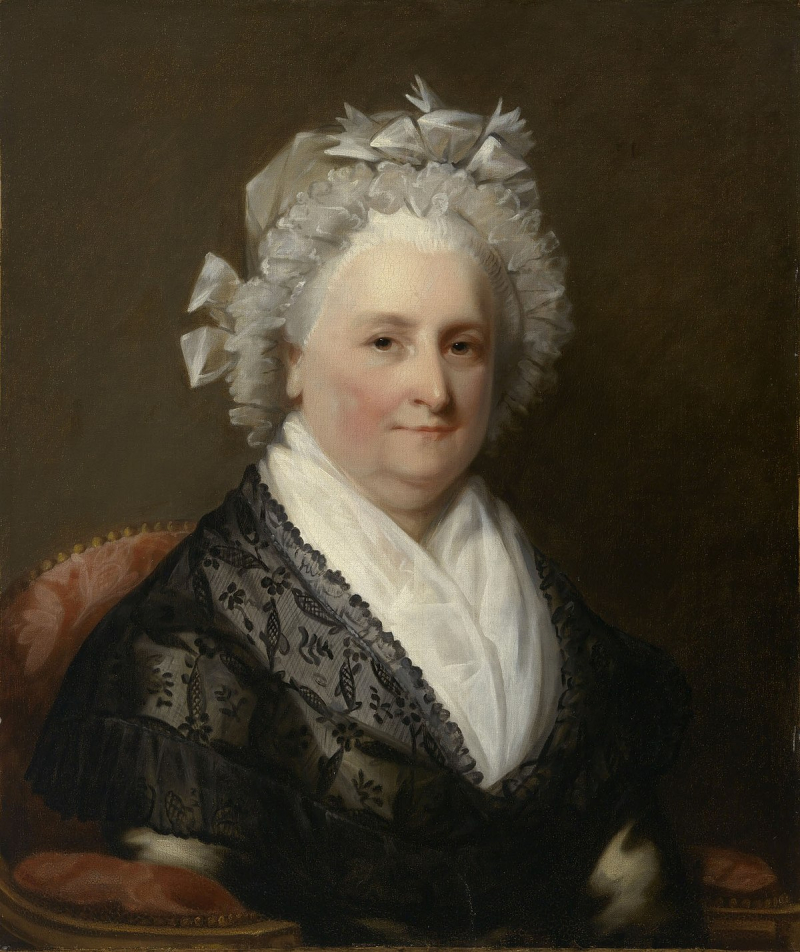
Martha Washington - Wikipedia 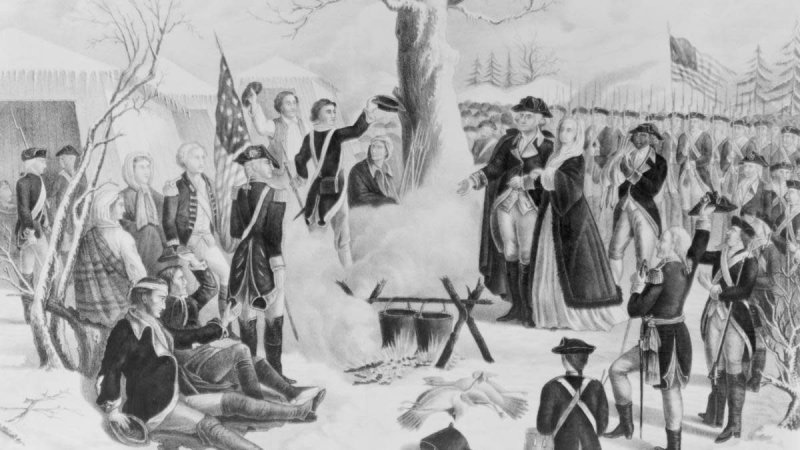
Photo: www.history.com -
Washington was 45 years old when his army encamped at Valley Forge, yet several of the general’s closest aids and advisors would probably still be in college today had they lived today. They are Marquis de Lafayette, Alexander Hamilton, and John Laurens. Childless Washington considered this triumvirate as the sons he never had.
The Marquis de Lafayette, a national hero in both America and French, commanding American troops in several battles, including the siege of Yorktown, was only 19 years old when he landed on American shores in the summer of 1777 to volunteer his services to the nascent United States. Washington’s chief aide-de-camp Alexander Hamilton, the man who was an influential interpreter and promoter of the U.S. Constitution, and was the founder of the Federalist Party, the nation's financial system, the United States Coast Guard, and the New York Post newspaper, was just 22 when he stood by his commander-in-chief’s side during that miserable winter.
Last but not least, Hamilton’s closest friend John Laurens, another of the commander-in-chief’s adjutants, turned 23 just weeks before the Continental Army limped into Valley Forge. He was an American soldier and statesman from South Carolina during the American Revolutionary War, best known for his criticism of slavery and his efforts to help recruit slaves to fight for their freedom as U.S. soldiers.
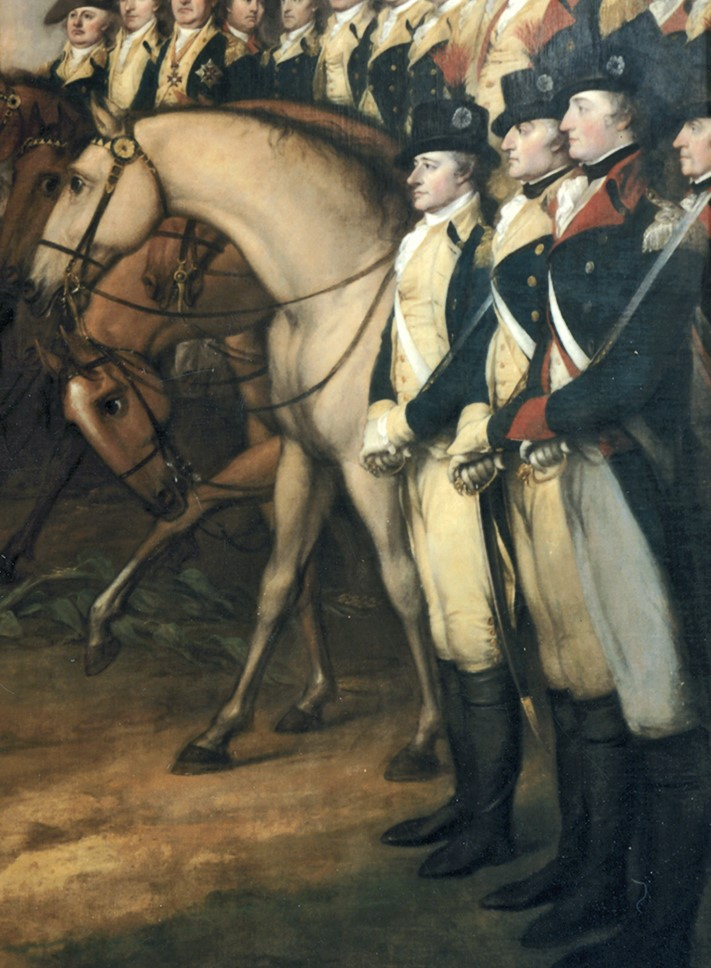
Marquis de Lafayette, Alexander Hamilton, and John Laurens - www.vnaha.com 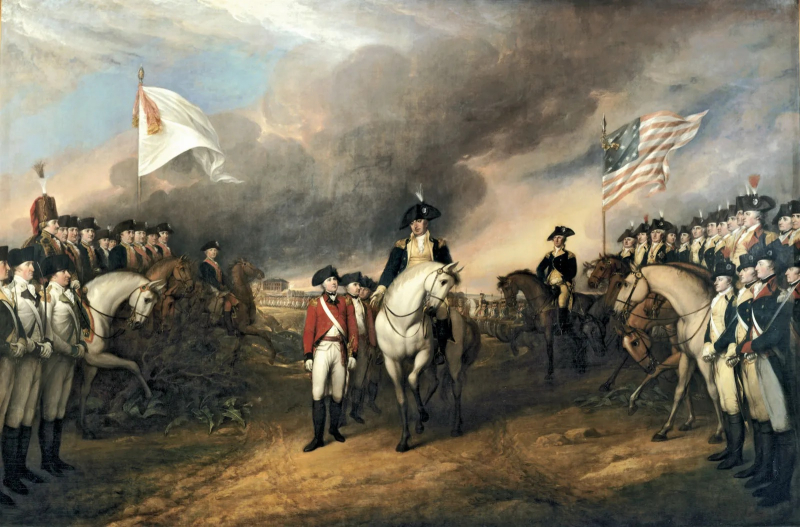
Marquis de Lafayette, Alexander Hamilton, John Laurens and Washington - www.britannica.com -
Nearly 250 years of legend have etched the impression of the winter of 1777-1778 as a perpetually snowbound season beset by bone-chilling temperatures, making the winter at Valley Forge the coldest winter of the war. Though the occasional blizzard, ice storm, and scattered snow squalls were relatively common on the Valley Forge encampment, it was by historical standards a fairly mild winter for southeast Pennsylvania. The following winter at Morristown, New Jersey, was a far colder winter.
The army’s commander-in-chief George Washington himself noted that consistently working and drilling in steady, below-freezing temperatures was preferable to slogging through an endless morass of slushy mud stippled with putrefying animal carcasses. Moreover, whenever the temperatures edged above freezing, the noxious veil of gasses escaping from the hundreds of starved horses buried in shallow graves hung over the camp. While it is true that nearly 2,000 of Washington’s soldiers at Valley Forge died from exposure, disease, starvation, or some combination thereof, this was more from a lack of clothing to defend themselves against the ever-shifting elements. Entire regiments were without shoes, and visitors were astonished to find half-naked and barefoot American sentries manning guard posts in the rain wrapped only in tattered blankets and standing on their hats to keep their feet warm.
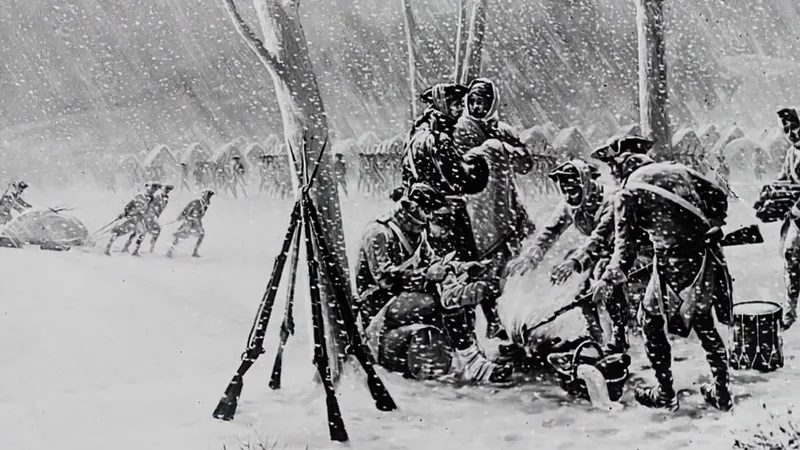
Photo: www.britannica.com 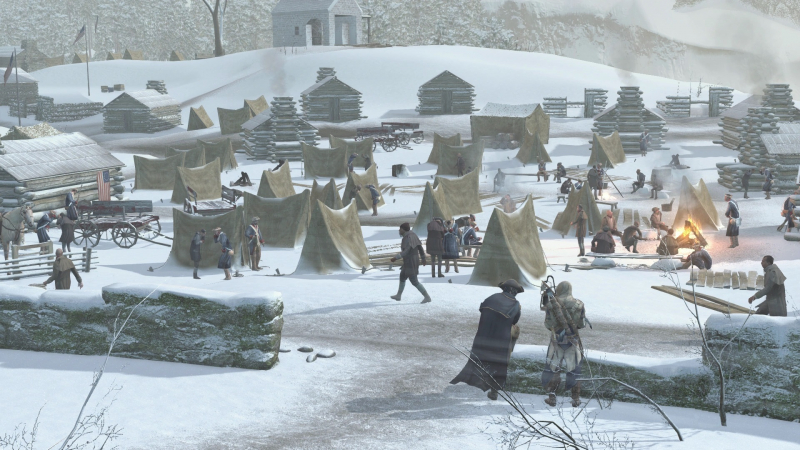
Photo: www.britannica.com














